Dogs love to be part of your life and the fact that they are a pet you can share so many experiences with is certainly one of the reasons why so many people love them. This also makes dogs a great companion on the trail. Whilst any dog that’s physically able will love to walk with you, not all dogs are naturally suited to lengthy hikes. In our guide, we’ll look at what makes for a great hiking dog and also look at some of the key breeds (and mixes!) you should consider if you are looking to adopt a new trail buddy.
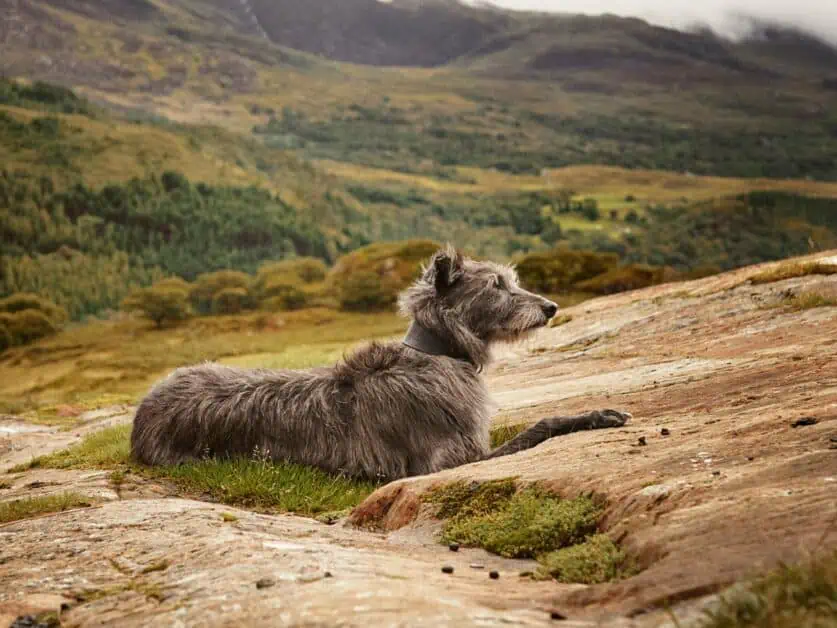
What Makes a Great Hiking Dog?
A great hiking dog isn’t just one that can follow you on a long walk without tiring out – though that trait certainly helps! There are several factors you should consider when deciding which dogs will be most compatible with you.
Energy & Stamina
High energy and stamina are key traits to look for in a hiking dog. Hunting dogs – like Sighthounds, Retrievers or Pointers – or working dogs like Sheepdogs – tend to excel here as these breeds were originally intended to perform physically intensive tasks often in difficult weather and in some cases, you’ll likely tire out long before the dog does on the trail! You need to build up to long walks and demanding hikes with any dog – don’t assume they be able to follow you on day-long hikes straight way. Dogs come in all sizes and larger dogs do not necessarily have more energy and stamina than smaller dogs.
Temperament
Whilst generalizations can be made about breeds, this will also vary from and depend on how a dog has been treated and trained before you took it on. Even-tempered dogs that will obey commands are the perfect combination here, but even more ‘difficult’ or independently minded dogs can make great hiking companions given the right training. Training is vital, but it can also be difficult, and some types of dogs are better suited to first-time or novice owners than others.
Hair Length
Dogs with shorter fur tend to require far less grooming and handle warmer weather better but also feel the cold. A dog coat should be considered essential if you want to take a shorter haired breed out in cold weather. Longer haired breeds tended to originate in cold places, and their longer, denser coats help them to keep warm and dry in cold and wet conditions. Dogs with longer fur need more grooming to help prevent matting and can overheat in very warm conditions.
Age
Whilst dogs sadly live far shorter lives than humans (around 10-15 years – this will vary from breed to breed), they age in the same way as we do: Young pups may be full of energy, but they will tire quickly. A healthy adult dog may well outlast you on the trail. Older dogs are slower. It’s important that you plan your hikes – and your expectations of what your dog can achieve – not just around its ability but age too.
Top 20 Hiking Dog Breeds
Below, we’ve listed 20 breeds and mixes worth considering if you want to take on a dog as a hiking buddy. Use these descriptions as a starting point only: it’s important that you understand a breed’s character, care requirements and peculiarities before you take an animal on. Much poor behavior in dogs is the result of owners not meeting their needs and many dogs are surrendered to shelters because of this and this is incredibly unfair on the dog.
Large Breeds
From friendly, smart Golden Retrievers to sleek and elegant Greyhounds, these animals will melt your heart and can also easily keep pace on even the longest of hikes. However, these powerful animals can be a handful and the more energetic and boisterous ones can be a bit of a handful and tricky to keep under control -especially if you are not so big yourself!
| Breed | Energy | Temperament | Stamina | Weather Adaptability |
|---|---|---|---|---|
| Bernese Mountain Dog | Medium | A gentle giant | High | Good in cold weather - can overheat in warm weather |
| German ShorthairedPointer | High | Friendly | High | Generally good |
| Golden Retriever | Medium/High | Very Friendly | High | Generally good |
| Siberian Husky | High | Friendly but independent | High | Good in cold weather - can overheat in warm weather |
| Labrador Retriever | High | Very Friendly | High | Generally good |
| Standard Poodle | High | Friendly | High | Generally good |
| Greyhound | Medium/High | Mellow | High | Can get cold very quickly |
Bernese Mountain Dog
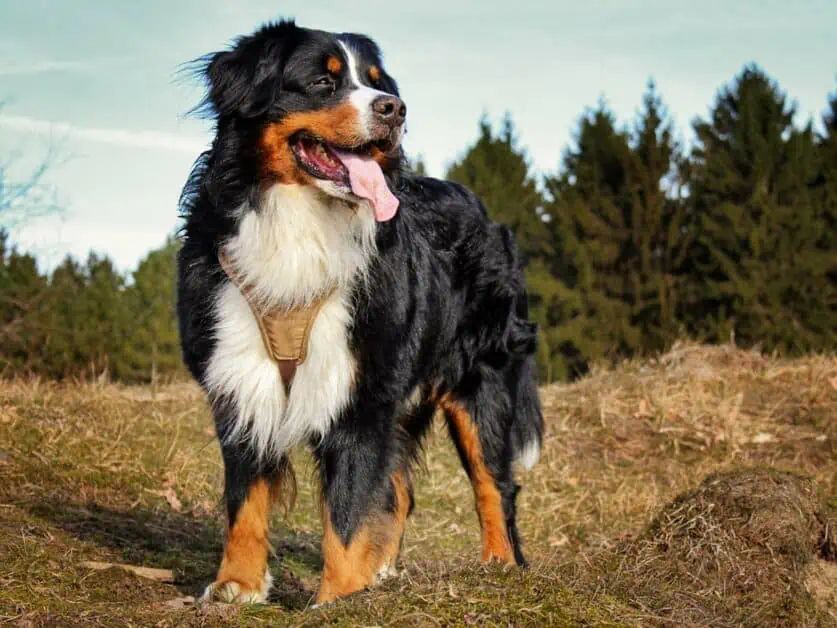
Bernese Mountain Dogs originated in the Bernese Alps in Switzerland. Bred as working animals, these large and powerful dogs are well adapted for life in the mountains, and this makes them excellent hiking companions. These dogs are adapted to Alpine environments and whilst they will do well in the cold, they will certainly overheat in warm conditions.
Energy and Stamina
These dogs were originally bred to carry out intensive work, so they are potentially very strong animals who can take long distance hikes in their stride.
Size
Bernese Mountain Dogs are very large. From a distance, their stocky build and predominantly dark coats can make them appear like bears! Fully grown, a male dog can have a shoulder height of up to 70cm/28in and wight over 52kg/115lb (females are a little smaller – but not by much!)
Intelligence and Trainability
The Bernese Mountain Dog is considered a gentle giant. They are considered a very intelligent breed and this, coupled with their generally calm personality, means that they are regarded as relatively easy to train and a good choice for a first-time dog owner.
Socialization
These are sociable dogs, and their gentle nature means they are not as ‘in your face’ as some other breeds. Bernese Mountain Dogs are often recommended for families with young children, and they can also be expected to get on well with other animals – though, of course, this will vary from dog to dog.
Noise Sensitivity
The cautious and gentle nature of these dogs means that they can easily be scared by loud noises. It’s recommended to incorporate exposure to loud noise into their training and to provide them with reassurance (and treats!) to support their adaptation to this.
Grooming
The Bernese Mountain Dog has a thick double layered coat and they shed year-round, with heavy shedding twice per year. These dogs require regular grooming to keep their coat from matting and itntop condition, though they do not need their coats trimmed.
Health
Hip and elbow dysplasia which can lead to osteoarthritis can be problems for Bernese Mountain Dogs as can Gastric Dilation Volvulus (GDV, also simply called ‘Bloat’). As with all animals, regular checkups with the vet are the best way to catch any problems early and to ensure your animal remains in peak health.
German Shorthaired Pointer
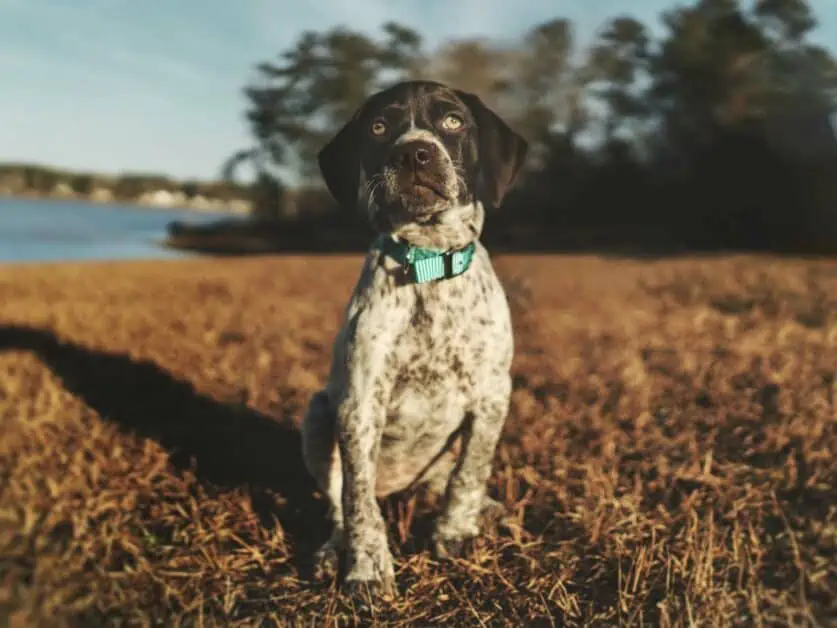
These dogs are renowned for their intelligence, athletic build, energy and, of course, their beautiful (yet very low maintenance!) sleek coats that come in a variety of colors and patterns. These dogs do well in water, and they are well suited as a companion on long hikes.
Energy and Stamina
The German shorthaired Pointer was originally bred as a hunting dog, and this adaptation to physically demanding work means that they can be a perfect companion on long-distance hikes.
Size
This is a large breed of dog. A full-grown, healthy adult male can be expected to have a shoulder height of 60cm/24in (or more!) and weight up to 27kg/60lbs. Females are a little smaller than this.
Intelligence and Trainability
German Shorthaired Pointers are considered an intelligent dog and, as such, they respond well to training. They are considered easy to train and are recommended for first-time dog owners.
Socialization
German Shorthaired Pointers are renowned for the strong bonds they form with humans. Whilst it will, of course, vary from animal to animal (and training will have a massive role here too), they are considered good with children and other pets.
Noise Sensitivity
Despite being bred as a gun dog, German Shorthaired Pointers are not inherently insensitive to loud noise and it’s important to work noise sensitivity awareness in training these dogs.
Grooming
As their name suggests, these dogs have a short coat – well suited to one of the breed’s original purposes of retrieving hunter’s kills from water. This short coat requires minimal grooming and a brush once a week is recommended.
Health
Hip and elbow dysplasia, which can lead to arthritis, Gastric Dilation Volvulus (GDV, or, simply ‘Bloat’) and eye issues can all be problems for German Shorthaired Pointers.
Golden Retriever
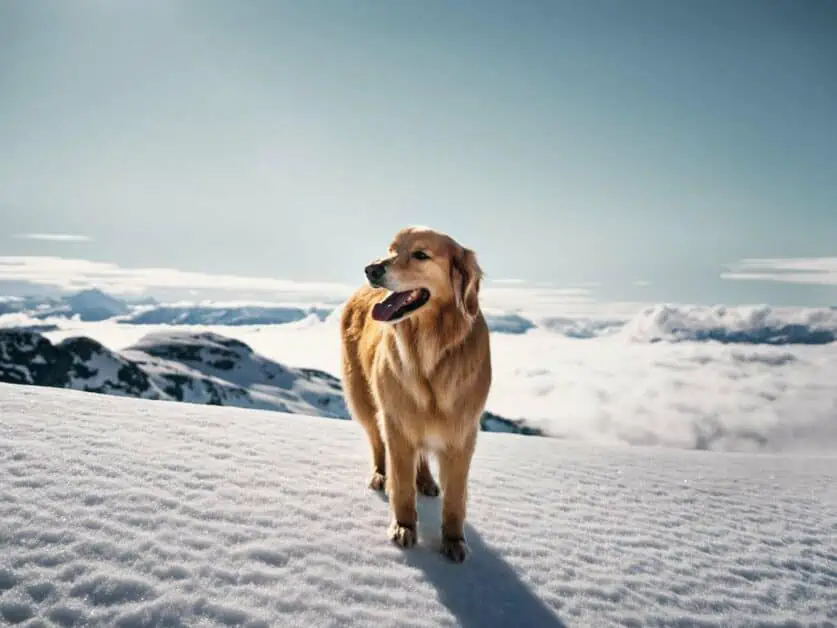
The Golden Retriever is one of the most popular breeds of dog in the world, and it’s not difficult to understand why: These handsome creatures have a reputation for intelligence, empathy, loyalty and a calm personality. Originally hunting dogs, these animals are a great companion on the trail.
Energy and Stamina
Golden Retrievers were originally bred to perform the physically demanding task of retrieving hunter’s kills from water. This means that with the appropriate experience, they are more than capable of being a companion on long, demanding hikes. Their gentle personality means that they are not as ‘in your face’ as some other breeds are.
Size
The Golden Retriever is a large dog. A fully grown and healthy adult male can have a shoulder height of up to 60cm/24in and can weigh up to 34kg/75lbs. Females are a little smaller than this.
Intelligence and Trainability
Golden Retrievers are renowned for their intelligence and ability to understand emotions. They can be trained to follow complex instructions and, as such, they are a preferred choice for service roles like therapy animals or guide dogs.
Socialization
Golden Retrievers socialize well. They are recommended as a breed for families with young children or other animals (though this can, of course, vary from dog to dog).
Noise Sensitivity
Golden Retrievers can be sensitive to loud noises and it’s important to incorporate acclimatization to this into their training.
Grooming
These dogs have dense, water-repellent, mid-length coats. They shed year-round and also have heavy shedding periods during the year. Regular brushing is important to help keep their coats in top condition and to prevent matting.
Health
These animals can suffer from heart conditions, cancer, Hip and elbow dysplasia (which can lead to arthritis) and Gastric Dilation Volvulus (GDV, or ‘Bloat’). As with any animal, regular veterinary visits and a healthy diet and lifestyle are key to keeping golden Retrievers in top health.
Siberian Husky
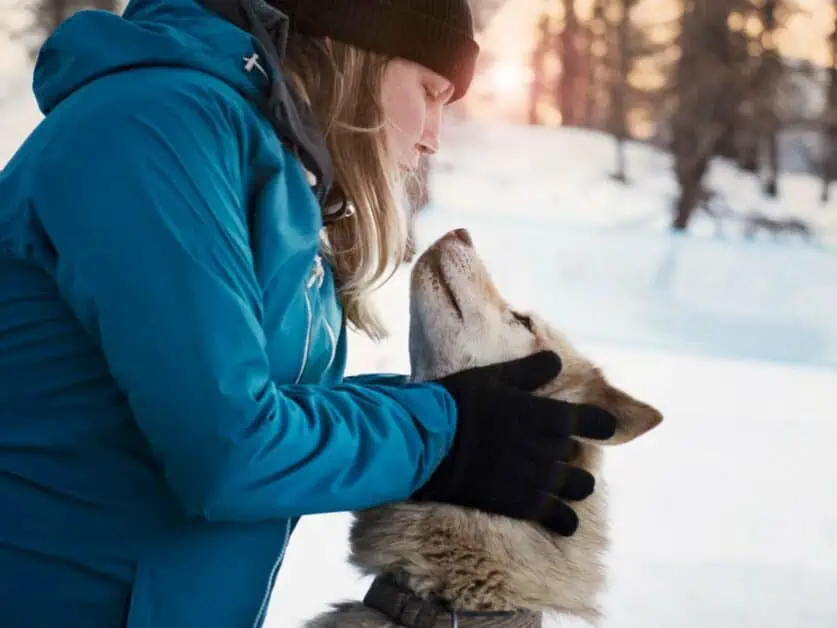
The Siberian husky is considered a pure breed, whilst the Alaskan Husky is not a standardized breed and can exhibit greater variance in size and appearance from dog to dog. The Alaskan Malamute is often lumped in with Huskies, and whilst it is similar in many ways, it is actually a separate breed that’s typically larger, more muscular and has denser fur than a Husky.
Energy and Stamina
These dogs were bred to pull heavy sleds through snow and therefore can have exceptional levels of energy and strength. You’ll likely get tired before a husky on the trail!
Size
Siberian Huskies are large dogs and a health adult male with have a shoulder height of around 60cm/24in and weight 27kg/60lbs. As you might expect, adult females are a little smaller than this.
Intelligence and Trainability
Siberian Huskies are intelligent dogs, but they are more independent and challenging to train than other breeds and are infamous for escaping from gardens and enclosures. These dogs are not recommended for novice owners.
Socialization
Siberian Huskies like to be part of pack – regardless of whether the other members of that pack are other dogs or humans. They are social animals and can be exceptionally friendly to humans, but poor behavior can develop if these dogs are not exercised enough (and they need a lot of exercise!) and some may mistake this for the dogs being anti-social.
Noise Sensitivity
Whilst it varies from dog to dog, Siberian Huskies generally have a reputation for being particularly sensitive to loud noises. As such, they are not recommended as pets in very busy or loud homes.
Grooming
Huskies are bred for Arctic conditions, and they have a dense coat that sheds regularly. They will need regular brushing and grooming to keep their coat from matting and in top condition.
Health
Siberian Huskies are prone to developing eye conditions as well as Hip and elbow dysplasia (which can lead to arthritis). Regular trips to the vet, a healthy diet and plenty (plenty!) of exercise are all key to ensuring a Siberian Husky stays in peak condition.
Labrador Retriever
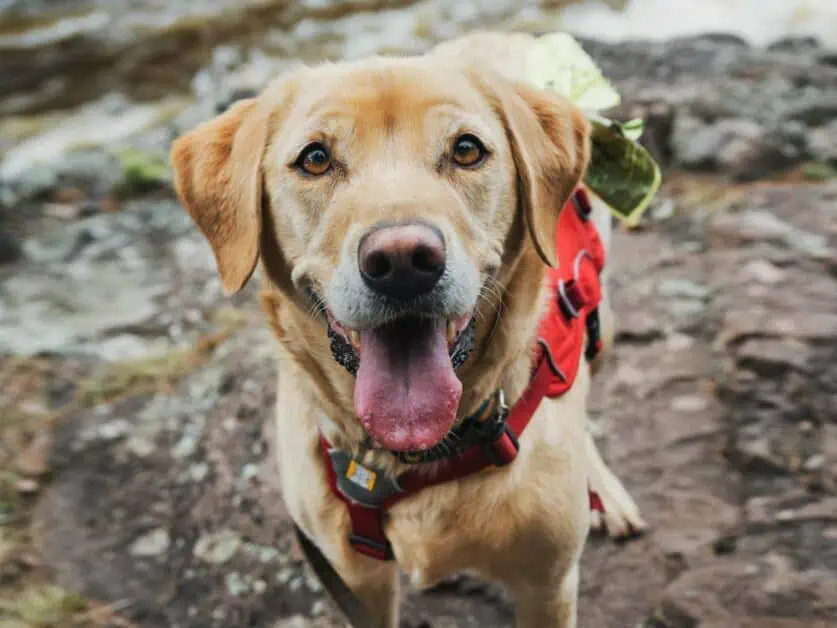
The Labrador Retriever is very similar to the Golden Retriever. These are one of the most popular breeds of dog in the world and their intelligence, mild temperament and trainability are certainly all factors in this. A Labrador is not just a short-furred Golden Retriever: they have a slightly stockier build and there are a few other subtle differences in body shape too.
Energy and Stamina
Originally bred for the physically demanding task of retrieving game birds from water for hunters, Labradors can also be a perfect companion on a hike. A healthy Labrador who’s used to hiking will have no problem keeping up with you and is unlikely to tire out before you do.
Size
Labrador Retrievers are large dogs – and can be very slightly larger than the similar Golden Retriever. A fully grown adult male can have a shoulder height of up to 62cm/24.5in and weigh up to 36kg/80lbs. Adult females are slightly smaller.
Intelligence and Trainability
The Labrador Retriever is considered a very intelligent dog. Similar to Golden Retrievers they are often chosen as service and therapy animals due to their capacity to be trained to follow complex commands and also their ability to recognize and empathize with human emotions. Labradors are considered easy to train and as such are a great choice for novice dog owners.
Socialization
Whilst it can vary from dog to dog, Labradors have a reputation for having gentle personalities, and this makes them a great choice of pet for families with small children and other animals. They are not as ‘in your face’ as some other breeds.
Noise Sensitivity
Like all dogs, Labradors can be sensitive to loud and sudden noises. It is important to integrate awareness of this into any training the dog receives.
Grooming
Labrador Retrievers have a short but dense double coat and they do shed a lot. Whilst their shorter coat means they don’t need to be groomed as often as the longer haired Golden Retriever, regular brushing is still advised to help keep shedding under control.
Health
Labradors are generally a healthy breed, but, like Golden Retrievers, there are certain conditions they can be prone to including Hip and elbow dysplasia (which can lead to arthritis), cancer, heart problems and Gastric Dilation Volvulus (GDV, or ‘Bloat’). A healthy lifestyle and balanced diet are the best ways to keep a Labrador in tip-top condition.
Standard Poodle
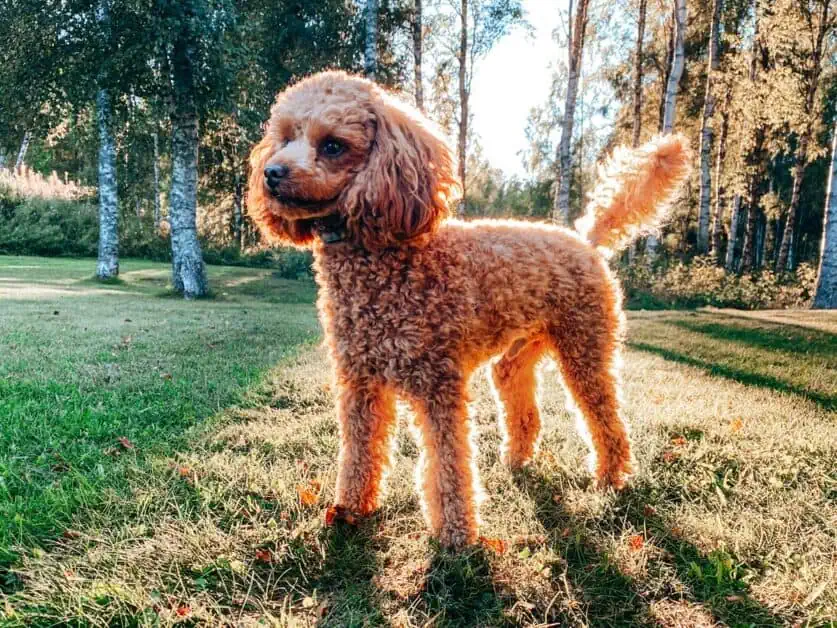
The stereotypical image of this breed does not fit with that of a companion on long hikes. But poodles were originally bred in Germany as retrievers – their job was to return waterfowl to hunters from bodies of water. The extravagant haircut often associated with show poodles is rooted in the practicalities of retrieving work too: the short sections would help the prevent the dog’s coat from snagging on underwater hazards whilst the longer sections provided padding and extra insulation around the dog’s joints, vital organs and tail.
Energy and Stamina
Originally bred as retrievers, Poodles have a lot of energy, and need regular exercise to help burn this off. As such they make great hiking companions. Their thick coats help keep them warm in colder conditions and can also be trimmed short to help keep them comfortable during the warmer summer months.
Size
There are three different sizes of Poodle: The Standard Poodle is the largest followed by the Miniature and the Toy. A full grown healthy adult male will have a shoulder height of around 56cm/22in and can weight up to 27kg/60lbs. Females are a little smaller than this.
Intelligence and Trainability
Poodles are considered a very intelligent breed and respond eagerly and well to training. The breed has a long history of being trained as show and circus dogs, which is a testament to how well they respond to training.
Socialization
Well-trained Poodles are generally considered to be loving and loyal pets. If they are trained well and exercised regularly to help them burn off their energy, a Poodle will present a calm and polite personality. Poodles can make a great family pet, are a good choice for inexperienced or first-time owners and are good with children and other animals if trained and socialized properly.
Noise Sensitivity
As with all animals, Poodles can be very sensitive to loud and sudden noises. The dog’s training should incorporate awareness of this.
Grooming
Poodles have a dense and curly coat that grows constantly, and they do need regular professional grooming and coat trims (every 4-6 weeks is recommended). Poodles are considered a hypoallergenic breed so are a great choice for those who suffer from allergies. It’s impossible to talk about Poodles without mentioning the various elaborate show cuts associated with this breed. These are still popular, but they are very high maintenance and also very far from necessary. With a more basic and easily maintained trim, Poodles become a large shaggy dog and many prefer this more natural look.
Health
Poodles are generally considered a healthy breed, but owners should look out for certain conditions the breed can be prone to including joint problems and epilepsy. Regular visits to the vet plus plenty of regular exercise and a healthy diet are key to keeping a Poodle in its best health.
Greyhound
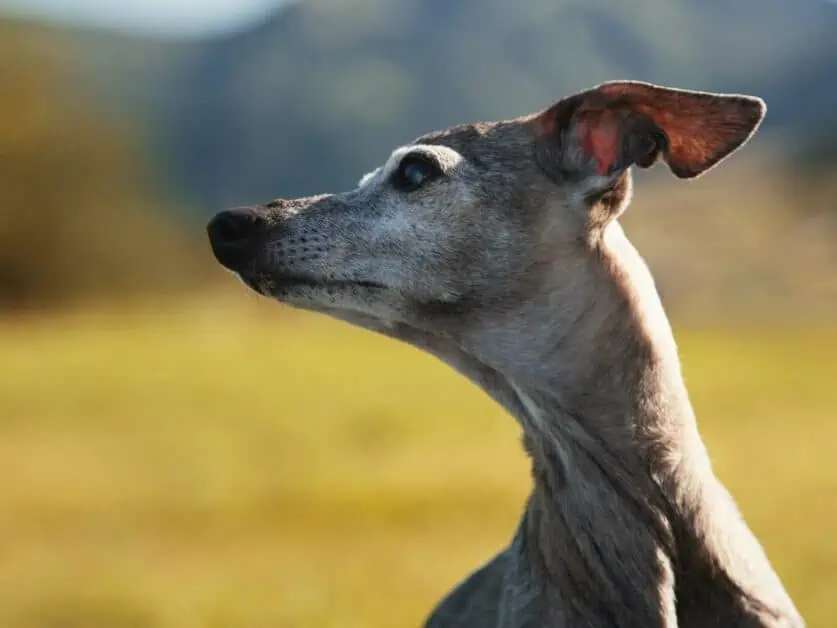
Elegant, playful, and affectionate Greyhounds make for fantastic pets and, contrary to what many people think, they do not require as much exercise or space as some other large breeds, and they are also happy to spend their time curled up in their beds or on the sofa making them a popular choice for those who live in apartments or who work during the day. Adopting retired racing Greyhounds is increasingly popular and this is a great way to give a former working dog a very happy life.
Energy and Stamina
Greyhounds are built for speed and for chasing down prey. They can run faster than an Olympic Sprinter, but can’t maintain this pace for long. However, they are also very happy to walk along at a regular walking pace and, if they are used to the level of activity, will happily follow you for a full day of hiking. With their lean, muscular build and very short fur, these dogs can feel the cold very quickly and for walks in colder weather it’s strongly advised to get an insulated coat for your Greyhound.
Size
Greyhounds are large dogs and a healthy adult male will have a shoulder height of up to 76cm/30in and weigh up to 40kg/88lbs. Females are slightly smaller and lighter.
Intelligence and Trainability
Greyhounds are considered intelligent dogs and they respond well to training. However, these sighthounds have an instinct to give chase (especially so in former racing dogs that have been trained to chase a lure) and if they see a small creature and this instinct can take over even in the most rigorously trained dog. It’s recommended to keep greyhounds on leads and muzzled when walking them until you are completely confident of their training and behavior.
Socialization
Greyhounds have a reputation for being gentle, easy-going dogs that don’t need constant attention. They can get on well with young children. Be very careful about introducing them into homes with other, smaller pets as their chase instinct is strong (though, with the right training, greyhounds and other animals like cats can get on just fine).
Noise Sensitivity
Like all dogs, Greyhounds can be startled by sudden or loud noises and it’s important that their training contains routines to help them adapt to this. This is especially important with fast-moving Greyhounds because if they are startled whilst off-lead outdoors they can very quickly run a long way away.
Grooming
Greyhounds have a very short coat and do not require regular grooming. That said, many dogs enjoy being brushed, and even if they don’t necessarily need it, it can be a great way to bond with your animal.
Health
Greyhounds are generally a healthy breed, but there are certain health conditions they can be prone to including Gastric Dilation Volvulus (also called GDV, or ‘Bloat’). Their long thin legs can also get injured when they run quickly, so be aware that if a greyhound is limping or standing a bit oddly, it may have injured itself during a sprint. Finally, Greyhounds are naturally very thin, and many well-meaning owners will inadvertently overfeed their pets causing the dog to become obese. A healthy diet and plenty of exercise are key to keeping a Greyhound in top physical condition.
Medium Breeds
Many people favor medium sized breeds as they are more manageable than larger dogs. These animals can have big personalities and Sheep Dogs like the Australian Shepherd and Border Collie are very popular pets for this very reason.
| Breed | Energy | Temperament | Stamina | Weather Adaptability |
|---|---|---|---|---|
| Australian Shepherd | Very High | Friendly and in your face | High | Generally Good |
| Border Collie | Very High | Friendly and in your face | High | Generally Good |
| Dalamtian | High | Friendly but independent | High | Generally Good |
| Nova Scotia Duck Tolling Retriever | High | Friendly | High | Generally Good |
| Lurcher | Medium/High | Friendly | High | Generally Good |
| Airedale Terrier | Medium/High | Friendly but stubborn | High | Generally Good |
| Labradoodle | High | Friendly and energetic | High | Generally Good |
Australian Shepherd
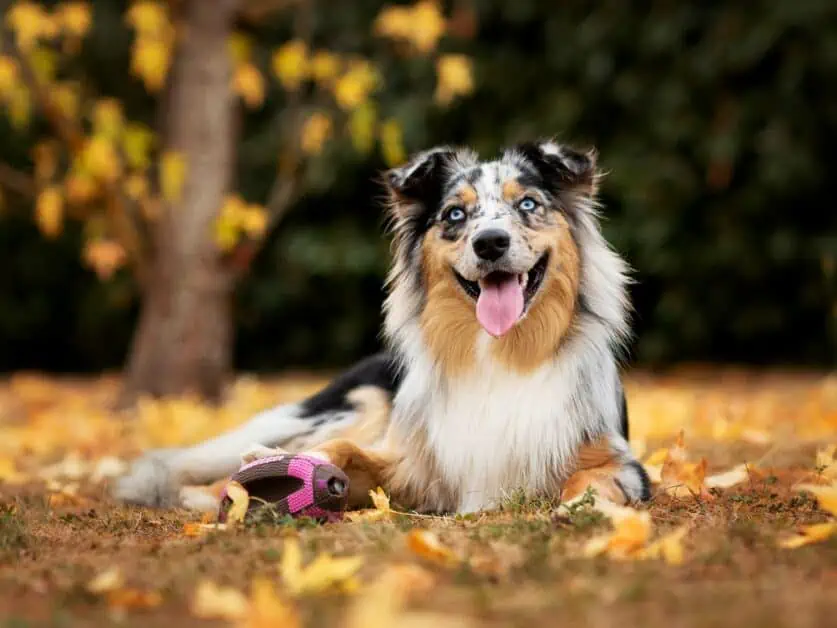
The friendly and strikingly beautiful Australian Shepherd is a great companion on the trail. Contrary to its name, the breed originated in America. These dogs were originally bred to heard sheep and the instinct to corral anything they encounter is still strong in these animals. These dogs often have strikingly colored coats and will commonly also have differently colored eyes (Heterochromia to use its proper name).
Energy and Stamina
These dogs are abundantly energetic and like to be the center of attention. Bred as working animals that would spend long days herding sheep, the Australian Shepherd is certainly capable of tagging along on the longest hikes. Like all dogs, they need regular exercise, but they also benefit from performing tasks like agility training or even actual herding.
Size
The Australian Shepherd is a medium sized dog. A fully grown and healthy adult male can have a shoulder height of around 58cm/23in and weigh up to 18kg/40lbs – though it’s not unusual for them to be smaller than this. Females are typically a little smaller than males.
Intelligence and Trainability
These dogs are considered intelligent, and they typically respond positively and eagerly to training.
Socialization
Australian Shepherds are friendly and sociable animals. They typically do well with children and other animals. Typically, they love to be the center of attention. If they do not receive enough exercise, this can translate into misbehavior, so it’s vitally important to meet this need for their true, friendly nature to shine through.
Noise Sensitivity
Australian Shepherds can be startled by loud or sudden noises, and it is important to address noise sensitivity in their training.
Grooming
Australian Shepherds have a dense, mid-length double coat and these dogs often have striking combinations of fur color. Their coats require regular grooming to prevent matting.
Health
Generally, Australian Shepherds are a healthy breed, but they can be prone to Hip and elbow dysplasia (which can lead to arthritis) and epilepsy too. Regular checkups with a vet plus a healthy diet and regular exercise are the best way to keep and Australian Shepherd – or any dog, for that matter – in top health.
Border Collie
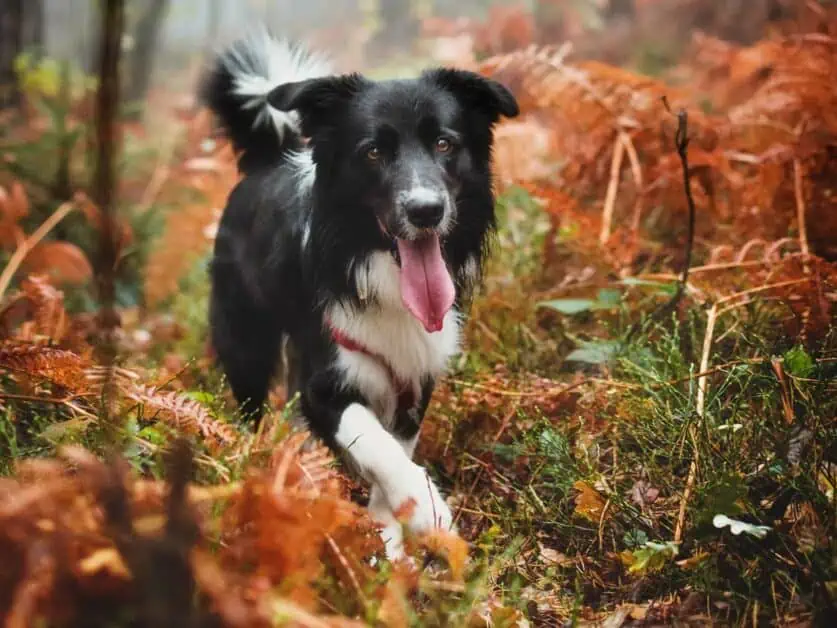
The Border Collie is one of the most iconic sheepdog breeds. Originally bred in the north of England, these hardy dogs are known for their intelligence, boundless energy and their piercing stare – they use eye contact to herd sheep. These dogs make a fantastic pet and have the energy and stamina to hike all day long, but they need plenty of exercise to burn off their abundance of energy and they will also want to be involved in everything you do.
Energy and Stamina
Border Collies were originally bred as working dogs to herd sheep in the often very cold and wet north of England. They are adapted for physically demanding work in harsh conditions and as such, they are more than up to the task of accompanying their owners on lengthy hikes, even across challenging terrain.
Size
Border collies are medium-sized dogs and a healthy, fully grown male will have a shoulder height of up to 56cm/22in and will weigh up to 20kg/45lbs. Females are a little smaller than this – but not by much.
Intelligence and Trainability
Border Collies are considered very intelligent. They respond eagerly and well to training and excel at activities like agility trials and obedience. Border Collies are known for their energetic personalities, and they maintain a strong urge to herd. It’s very important that they receive sufficient exercise to allow them to burn off their energy, otherwise they may appear to be behaving badly or mischievously.
Socialization
Border Collies are regarded as very sociable animals. They make great family pets and can get on well with young children and other animals. However, they have an instinct to herd and if no sheep are available, they will try to herd humans, other animals or anything that can move and one of the tactics they use to achieve this is to nip. It’s important for prospective owners to be aware of this facet of their personality and train around it if needed.
Noise Sensitivity
Like all dogs, Border Collies can be startled by loud or sudden noises and it’s important that this is addressed in their training.
Grooming
Border collies have a dense mid-length coat that needs regular grooming to prevent matting and to keep it looking its best.
Health
Generally, border Collies are a healthy breed, but they can be prone to certain conditions like Hip dysplasia (which can lead to arthritis) and Collie Eye Anomaly (CEA, which can lead to blindness). As with all animals, regular visits to the vet, a healthy diet and regular exercise are key to keeping a Border Collie in optimum health.
Dalmatian
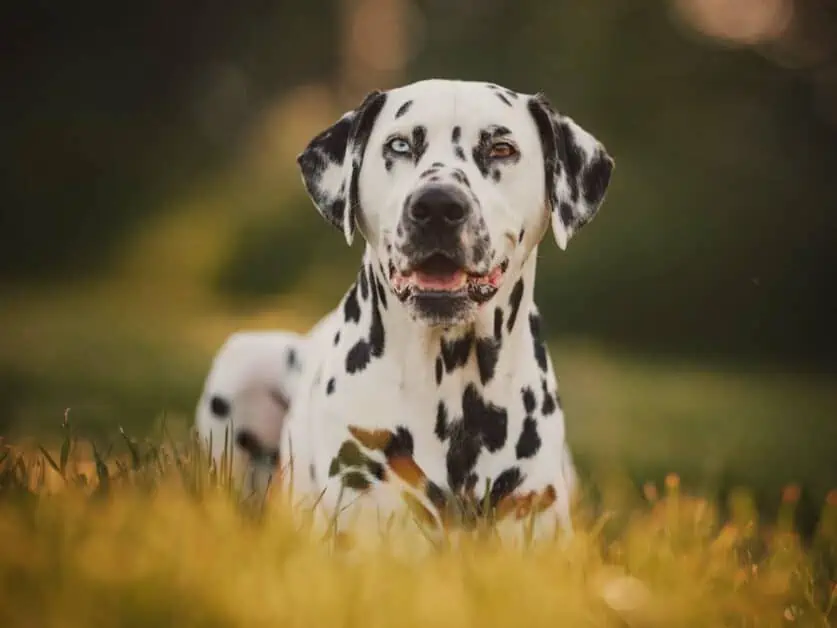
The iconic Dalmatian is probably the most instantly recognizable breed of dog. Even if you don’t know much about dogs, you likely know what a Dalmatian looks like! These medium sized dogs were originally bred in the Dalmatia region of current day Croatia to run alongside and guard horse-drawn carriages.
Energy and Stamina
Dalmatians were bred so they have high energy and stamina in their genes. They are well suited as hiking companions and will have no problem with following their owner on an all-day hike, provided they have the experience and training. On the flip side, Dalmatians are not a great choice for those who cannot meet their exercise needs – so think carefully if you only occasionally embark on longer hikes and you plan to make up most of your dog’s exercise with shorter, local walks.
Size
The Dalmatian is a medium dog, and a healthy adult male can have a shoulder height of up to 60cm/24in and weight up to 25kg/55lbs. Females are smaller.
Intelligence and Trainability
The Dalmatian is considered an intelligent dog, and they can respond well to training. However, they are also known to be stubborn, and they can require more intense training than some other breeds.
Socialization
Dalmatians are generally friendly, sociable animals that stick close to their humans. They can get on well with other animals and young children provided they have appropriate training, but they do need a lot of attention and physical activity. Stories about them being antisocial or aggressive typically relate to animals that are not getting their social and physical needs met by their owners.
Noise Sensitivity
All dogs can be startled by sudden or loud sounds and Dalmatians are no exception. Owners should be sure to integrate noise sensitivity into their animals training form an early age.
Grooming
Most people think of the famous Dalmatian coat as being white with black spots, but liver spotted Dalmatians have chocolate brown spots on white. All Dalmatians have a short coat that requires minimal grooming. Even though they might not need it, grooming is generally enjoyed by dogs and it’s a great way to bond and to meet some of their social requirements.
Health
Dalmatians are generally a healthy breed, but as with any pet, regular checkups with a vet alongside a healthy diet are key to keeping the animal in top shape. Dalmatians are prone to urinary stones, so access to ample fresh water and a vet-approved diet are especially important with this breed.
Nova Scotia Duck Tolling Retriever
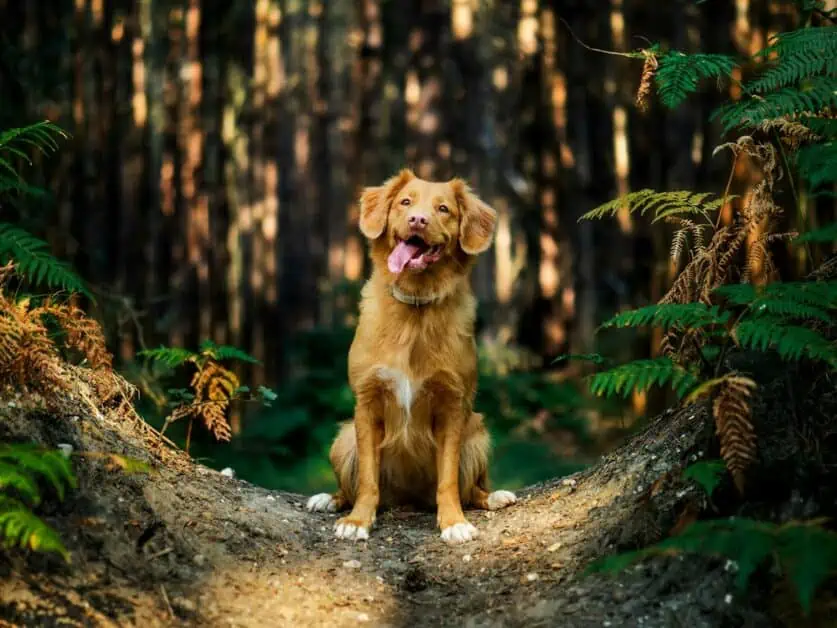
The energetic, smart and friendly Nova Scotia Duck tolling Retriever was, as the name suggests, originally bred in Canada as a hunting dog. This medium breed is often mistaken for a miniature Golden Retriever. Whilst there are many similarities between these two dogs, they are separate breeds. Their reddish fur, often with white accents, certainly makes them a visually striking animal.
Energy and Stamina
These dogs were originally bred for the physically demanding task of ‘tolling’ water birds: luring them into range of hunter’s guns and subsequently retrieving the kills from water in the often freezing-cold landscape of Nova Scotia. This means that with the right training, these animals can be hardy, energetic companions on long hikes.
Size
The Nova Scotia Duck Tolling Retriever is a medium-sized dog – smaller than the otherwise physically similar Golden Retriever. A Fully grown and health adult male will have a shoulder height of up to 53cm/21in and will weight up to around 20kg/45lbs. Females are generally a little smaller.
Intelligence and Trainability
Like most Retrievers, the Nova Scotia Duck Tolling Retriever is considered an intelligent breed, and they can respond very well to training. However, these dogs are not considered as receptive to training as the larger Golden and Labrador Retrievers and for this reason they are not recommended for complete novice dog owners.
Socialization
Nova Scotia Duck Tolling Retrievers are regarded as friendly and sociable animals. They can make for great and loyal pets and are recommended for active families with small children. However, these animals can have an independent streak and have a strong urge to hunt small animals. They may need extensive training if you wish to bring one into a household with other pets like cats. These animals can howl loudly which can certainly be an issue if you live in, say, an apartment.
Noise Sensitivity
Like all dogs, and a lot of people, Nova Scotia Duck Tolling Retrievers can be startled by loud or sudden noise. It’s important to work noise awareness into their training.
Grooming
Their dense, waterproof coat is medium length and requires brushing to help prevent it from becoming matted. They do shed, and sometimes quite heavily too. Their coat does not require trimming and in this regard, it is considered low maintenance.
Health
The Nova Scotia Duck Tolling Retriever is generally a healthy breed. They can occasionally suffer from epilepsy and hip dysplasia – a joint problem that can lead to arthritis. A balanced diet, regular exercise and, of course, regular visits to the vet are all key to keep this breed – or indeed any dog – in their best health.
Lurcher
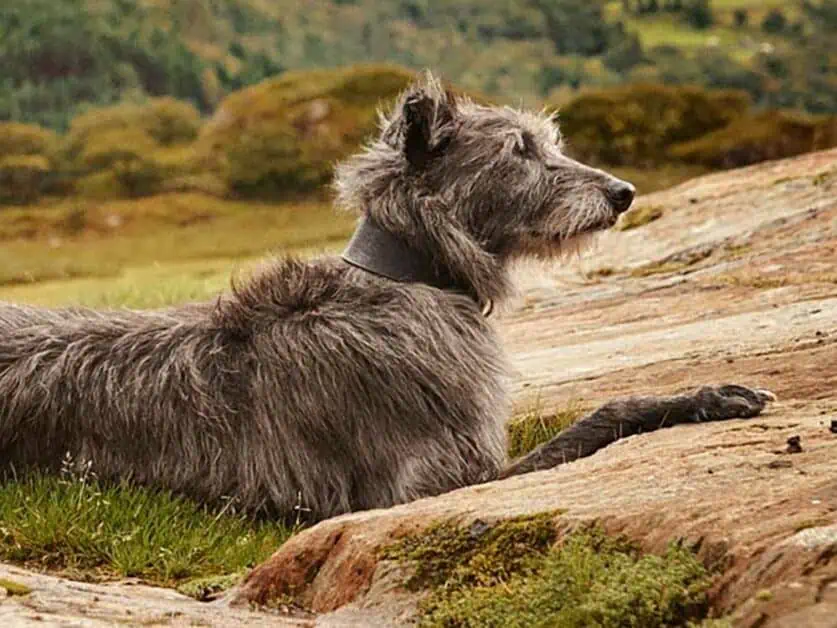
Lurchers are a hybrid of a sighthound with a working dog and not a specific breed themselves. They originated in Great Britain and Ireland and date back to a time when only nobility was allowed to legally own true hunting dogs. The mixed Lurcher allowed commoners to own a hunting animal without falling foul of the law. Lurchers have the speed and agility of a sighthound with the intelligence of a working dog and these qualities are greatly appreciated and admired by their owners.
Energy and Stamina
As mentioned at the start, Lurchers are a cross between a sighthound and a working dog – both types of dog that are capable of physically demanding work. With the right training, a lurcher will happily follow you on the longest of hikes.
Size
The size and general appearance of Lurchers can vary quite considerably depending on which breeds the dog is a mix of. Lurchers that contain some Wolfhound or Deerhound can be truly massive. However, most lurchers are considered medium-sized dogs and generally they’ll have a similar thin, athletic frame to a Greyhound or Whippet.
Intelligence and Trainability
Lurchers are generally considered to be smart animals and they can be very receptive to training – though, of course, this can vary from dog to dog and is also influenced by what breeds make up the mix.
Socialization
Lurchers are mild and gentle and can be great pets for families with small children. Lurchers maintain many Sighthound traits: On one hand this means they can be more than happy to curl up on the sofa all day without needing to be the center of attention, but on the other, it means they have a strong instinct to chase and this means that some Lurchers are not suitable for homes with other animals like cats (though, with the right training, a suitable Lurcher can co-habit with a cat just fine).
Noise Sensitivity
Like all dogs, Lurchers can be distressed by sudden or loud noises. It’s important to build noise awareness into their training to help minimize the negative impact this can have.
Grooming
The appearance of lurchers can vary greatly. Many have short coats like a Greyhound that need minimal grooming whereas others have shaggy mid-length coats similar to a Wolfhound (indeed Lurchers can look like miniature Irish Wolfhounds) and these dogs will require more frequent grooming.
Health
Lurchers are generally healthy dogs but they are prone to certain health conditions such as Gastric Dilation Volvulus (GDV, or ‘Bloat’) and Osteosarcoma – a type of bone cancer. Regular trips to the vet plus a healthy diet and lifestyle are all keep to keeping a lurcher in the best possible health.
Airedale Terrier
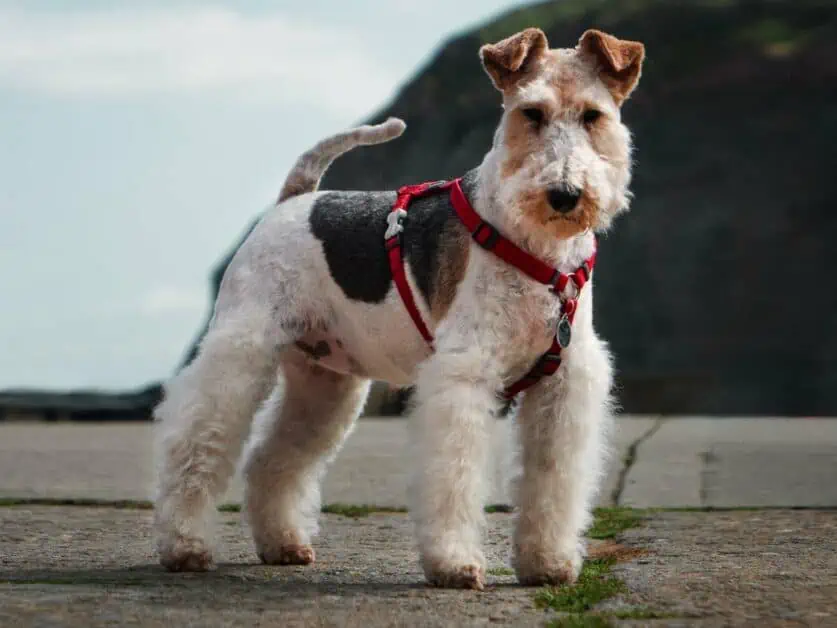
The striking Airedale Terrier is sometimes called the ‘King Of Terriers’. Originating in the 19th century around Airedale in the North of England, these Terriers were bred to hunt rats and ducks. With a strong independent spirit that can verge on stubbornness, Airedale Terriers – and Terriers in general – are not universally popular amongst dog owners, but they are none the less loved pets for countless people and their energy and stamina also makes them great companions on the trail.
Energy and Stamina
The Airedale Terrier was originally bred as a working dog for both hunting and pest control. These dogs are known for their high energy levels and long walks and hikes are the perfect way to help burn this off. These dogs’ benefit from engaged play sessions as well as just walks, so throwing a few dogs toys in your hiking pack is never a bad idea.
Size
The Airedale Terrier is a medium sized dog and largest Terrier breed. Fully grown, healthy adult males will have a shoulder height of up to around 60cm/23in and can weigh up to around 30kg/70lbs. Females are typically a little smaller than males.
Intelligence and Trainability
Airedale Terriers are intelligent dogs, but they are also independent and can be stubborn too – both of which can impact how easy they are to train.
Socialization
Airedale Terriers are known for forming strong bonds with their owners and they make for a good family pet. Their strong sense of independence can be problematic for inexperienced owners, but with the right training and Airedale terrier will socialize well.
Noise Sensitivity
As with all dogs – and humans too – Airedale Terriers can be sensitive to loud and sudden noises, and awareness of this should be built into their training.
Grooming
Airedale Terrier’s wiry coats are of the reasons why so many people are drawn to the breed. Contrary to what you may think, their coasts do not need very frequent grooming, though weekly brushing session are advised as a minimum. Even if the dog doesn’t need it, may dogs enjoy grooming and it’s a great way to build a bond between human and animal.
Health
Airedale Terriers are generally a healthy breed. They can be prone to Hip Dysplasia, which can lead to arthritis and a vet will also pay particular attention to their teeth and ears during checkups – which are key to keeping these dogs in best health alongside a good diet and plenty of exercise.
Labradoodle
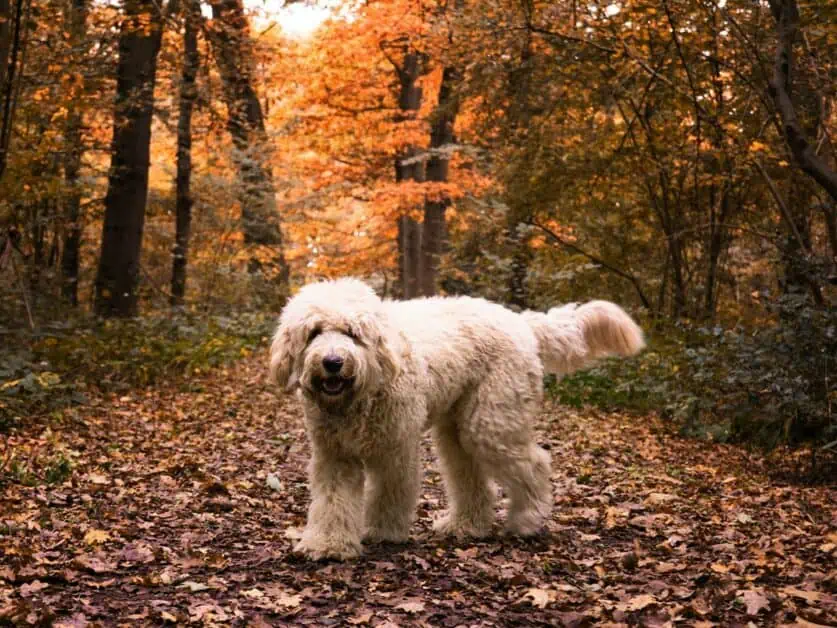
As the name suggests, the Labradoodle is a cross between a Poodle (either a ’full sized’ standard or the smaller miniature) and a Labrador Retriever. Labradoodles are a very popular choice of pet and with their teddy-bear looks and warm personalities, it’s not hard to see why. Both the Poodle and Labrador have already been mentioned in this article and the Labradoodle is just as capable of being a companion on long distance hikes
Energy and Stamina
The Poodle and Labrador Retriever both make excellent hiking companions and there’s no reason why a Labradoodle – which is a cross between these two – shouldn’t too. These dogs have a lot of energy, and they are a great companion for someone who hikes regularly.
Size
Labradoodles are not a standard breed, so their size can vary. Some are quite large dogs whilst many would likely be categorized as medium. It is always recommended to adopt animals, but if you are intent on purchasing a Labradoodle puppy, a reputable breeder will be able to talk you through the mix of their puppies which should give a good indication of what the adult dog’s size will be.
Intelligence and Trainability
Labradoodles are very intelligent animals and whilst they do respond well to training, many people who take these animals on do not fully understand their requirement for exercise and companionship. Many reports of ‘problem’ Labradoodles can be traced back to the animals not receiving the engagement they need to be happy.
Socialization
The intelligent Labradoodle is known for its friendly and outgoing personality and will bond closely with its owners, and with the right training, Labradoodles are a great choice for families with children and other animals – including cats. Labradoodles can become reliant on their owner’s presence, and this can manifest as poor behavior if the dog is left in an empty house whilst its owner works for examples. This is not the dog’s fault and prospective owners should ensure they can meet the dog’s social requirements before taking one on.
Noise Sensitivity
As with all dogs, Labradoodles are not inherently used to loud or sudden noises and it’s important that noise awareness is built into their training from an early age.
Grooming
Labradoodles have a mid-length curly coat similar to a Poodle. Like a Poodle, they are considered hypoallergenic, making them a good choice for those who suffer from allergies. They require minimal grooming and shed very minimally. Their coat should be brushed to help prevent matting and their fur should be trimmed in hot weather to help prevent the dog form overheating.
Health
Labradoodles are generally healthy animals, but there are certain conditions owners should be aware of including Hip and Elbow Dysplasia (which can lead to arthritis). Regular visits to the vet along with a healthy diet and regular exercise are the best way to keep any dog in the best possible health.
Small Breeds
Don’t let the diminutive size of some dogs fool you: small dogs can have energy, stamina and personalities far bigger than their physical size would suggest! Smaller dogs might need a helping hand on more technically demanding trails – a lift over rocks or streams for instance – but little dogs can make fun and hardy hiking companions.
| Breed | Energy | Temperament | Stamina | Weather Adaptability |
|---|---|---|---|---|
| Jack Russell Terrier | Exceptionally High | Friendly but very stubborn | High | Generally good |
| Miniature Poodle | High | Friendly | High | Generally good |
| Beagle | High | Friendly | High | Generally good |
| Shetland Sheepdog | Medium/High | Friendly | High | Generally good |
| Cockapoo | High | Friendly | High | Generally good |
| English Springer Spaniel | Very High | Friendly and in your face | High | Generally good |
Jack Russell Terrier
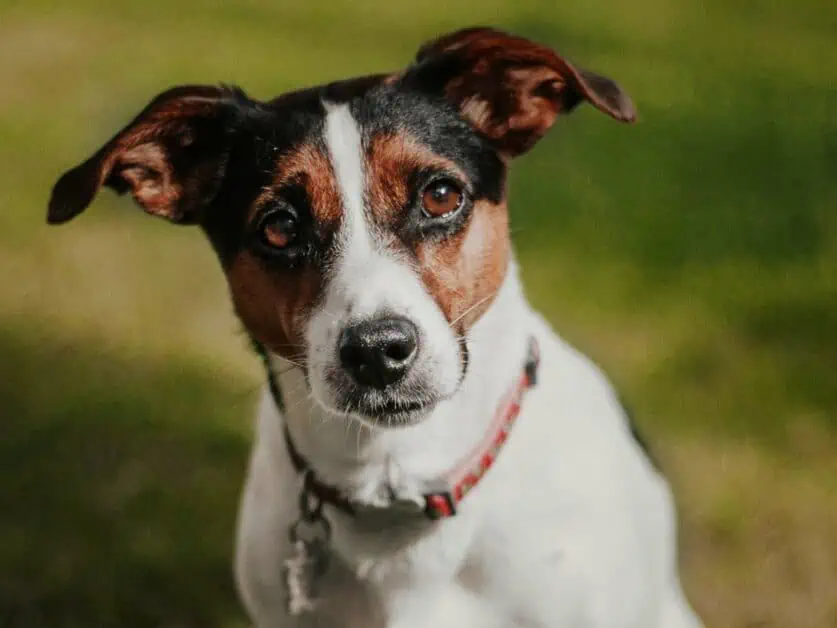
The Jack Russell Terrier has got to be one of the most well-recognized breeds of dogs and most people will surely have encountered one at some point or another. The breed originated in the south of England during the first half of the 19th Century and were originally bred as fox hunting dogs by a person named… Jack Russell! They can be a bit of a handful and they are suited to experienced dog owners who can give them the exercise and mental engagement they need.
Energy and Stamina
These small dogs might seem like they would tire quickly, but they were bred for a very physically demanding task and as such, with the right training, they will have no problem being your companion on long walks and hikes. These dogs require a lot of exercise – a lot more than you might imagine – and like to be engaged with games like fetch. If they don’t get the exercise and engagement they need, they can exhibit poor behavior – which, of course, is not their fault.
Size
Jack Russell Terriers are small dogs, and a large healthy adult male will have a shoulder height of around 30cm/12in and weigh up to around 6kg/13lbs. It’s not uncommon for health adult dogs to be smaller than this and females are generally smaller than males too.
Intelligence and Trainability
The Jack Russell Terrier is an intelligent dog, but they are also fiercely independent, and this can make them tricky to train. However, they certainly can be trained with perseverance and patience and can even be trained to carry out and follow complex tasks and commands.
Socialization
Jack Russell Terriers have big personalities and sometimes they can seem standoffish. Generally, they are regarded as being best suited for more experienced owners who can cater for their exercise and mental stimulation requirements. These dogs were bred as hunting animals and they have a strong urge to chase and dig and, with this in mind, they do not make good additions to houses with other pets and there are plenty of online testimonials of Jack Russell’s inflicting terrible injuries or even killing cats after years of seemingly peaceful cohabitation.
Noise Sensitivity
Despite their hardy image, Jack Russell Terriers can be startled and scared by loud noises and it’s important to integrate training around this as soon as possible to help mitigate the problems this can cause.
Grooming
Jack Russell Terriers have a short and dense coat that requires minimal grooming. However, even though they may not need it, most dogs like being groomed and regular grooming sessions are a great way for owners to engage and bond with their animals.
Health
Jack Russell Terriers are generally healthy dogs. They can be prone to hereditary deafness and eye problems. Regular checkups with a vet, plenty (plenty!) of exercise and a balanced diet are the best way to keep a Jack Russell in good health.
Miniature Poodle
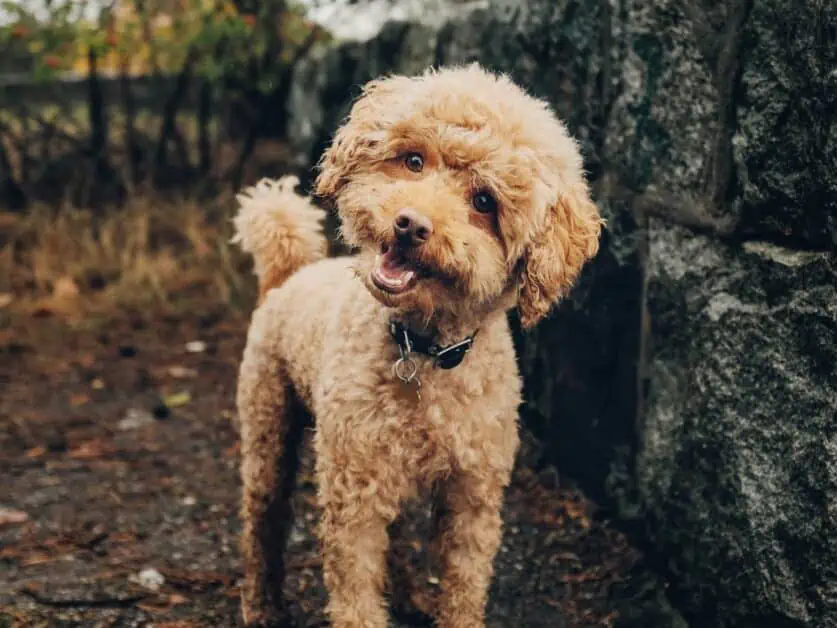
Most people think of poodles as immaculately preened show animals, but the truth is that the breed originated as a hunting dog and they have the physical adaptations to be excellent companions on the trail.
Energy and Stamina
Poodles were bred as retriever dogs, and this means they are physically adapted to demanding work. This is just as true for the Miniature as it is for the larger Standard Poodle. These dogs need regular exercise and can start to exhibit poor behavior if they do not receive (this, of course, is not the fault of the dog!).
Size
The Miniature Poodle is a small dog and healthy adults have a shoulder height of 25-38cm/10-15in and will weight in the region of 4.5-7gk/10-15lbs. Males are generally a little larger than females.
Intelligence and Trainability
Poodles are intelligent dogs, and they are very receptive to training. There’s a long history of Poodles be trained as performing animals in circuses and whilst such shows have fallen out of favor in modern times, it’s an endorsement of how these animals can learn to follow complex commands and carry out elaborate actions.
Socialization
Miniature Poodles are regarded as friendly animals – though of course this can vary from dog to dog and appropriate training plays a major role here too. Poodles of all kinds make for good family pets and can be good with children and other animals too. Poodles can become distressed if left alone for long periods of time – and that can include when you go to work. Sometimes, this can result in them howling, which can be problematic if they are left alone in an apartment.
Noise Sensitivity
As with all dogs, poodles are not inherently resilient to loud noises, and these can shock them and cause distress. It’s important that the dog’s training integrates strategies for dealing with loud noise to help prevent unnecessary distress to the animal.
Grooming
With a regular trim, a Miniature Poodle is shaggy dog – and many will prefer this more natural look. Poodles are considered hypoallergenic and shed very little meaning they are well suited pet for people who suffer from dog allergies. The Miniature Poodle’s dense curly coat does require regular grooming and can be trimmed short to help the dog better control temperature in warmer months.
Health
Miniature Poodles are generally a healthy breed, but, as with their larger relatives, there are a few health conditions to look out for including epilepsy and eye conditions. Regular checkups with a vet alongside a balanced and healthy diet plus plenty of exercise are the best way to keep a Miniature poodle – or any pet for that matter – in the best possible health.
Beagle
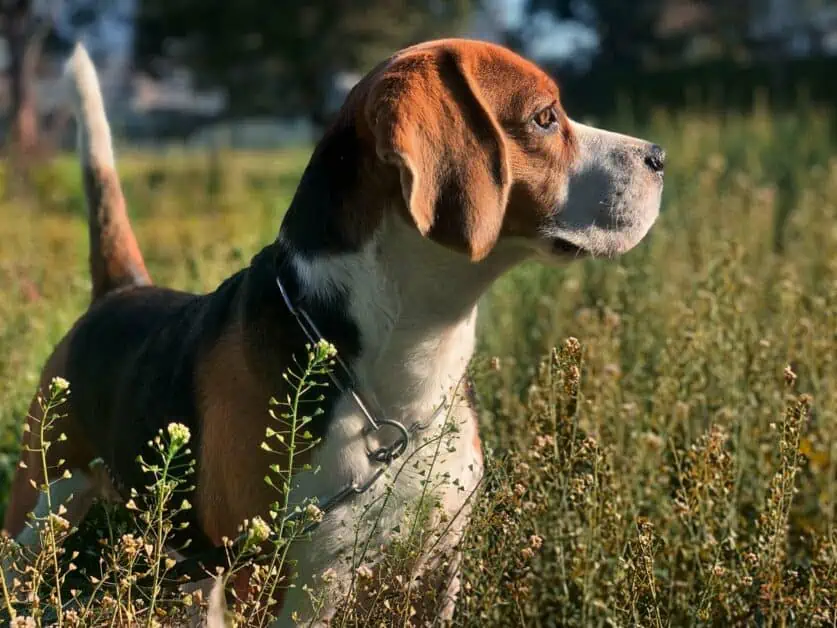
The Beagle is a breed with a very long history. Whilst the modern breed can be traced back to mid 19th Century England, predecessors to the modern Beagle crop up in the Middle Ages and were being used as hunting dogs in the Roman Empire – there may even be references to them in Ancient Greeks texts. Beagles are scent hounds, bred to track down prey for hunters and they have a characteristic nose to the ground stance. Beagles are generally very friendly but can also be mischievous too.
Energy and Stamina
Modern Beagles were bred as hunting animals, and as such the breed has a capacity for great energy and stamina. With the right training, a Beagle will have no problem following you on a long hike.
Size
Beagles are small dogs. A fully grown and healthy male will have a maximum shoulder height of around 38cm/15 and weigh up around 13kg/30lbs. It’s not unusual for adults to be smaller than this and, as with most dogs, females are generally a little smaller than males.
Intelligence and Trainability
Beagles are generally intelligent dogs, but they also have an independent streak which can make training – and especially house training – a challenge. Therefore, they are not the best choice for complete novice dog owners and prospective owners should thoroughly research and be sure they can provide the breed’s training requirements before taking on one of these dogs.
Socialization
Beagles are generally very friendly and outgoing animals – though training and each dog’s individual personality plays a role here. If Beagles are left alone for long periods of time – and this can include their owner going out to work – they can become bored and lonely and can resort to digging and howling. It is reported that many Beagles that wind up being surrendered to animal shelters get there because their howling causes problems for their owners. This behavior is a result of the animal’s social needs not being met, so it’s important to ensure you can meet these before you take one on.
Noise Sensitivity
Like most animals, Beagles can be startled and scared by loud or sudden noises. Their training should incorporate noise awareness to help minimize any distress this can cause the animal (and subsequently, the owner too!).
Grooming
Beagles have a short, dense coat that only needs occasional grooming. Remember that just because a dog doesn’t need to be groomed regularly, doesn’t mean that you shouldn’t do it regularly! Most dogs enjoy grooming and it’s a great way for owners to bond with their pet and to provide the animal with some of the mental stimulation and engagement it needs. Beagles can be prone to eye and ear infections and owners should check both these areas when grooming the animal.
Health
Beagles are generally healthy, but they can be prone to joint problems that can lead to arthritis and also to eye and ear problems. Beagles will also over-eat if given the chance which can lead to obesity, so monitoring their food intake is also particularly important. As with all dogs, regular check-up at the vet along with a good diet and plenty of exercise are key to keeping a beagle in top health.
Shetland Sheepdog
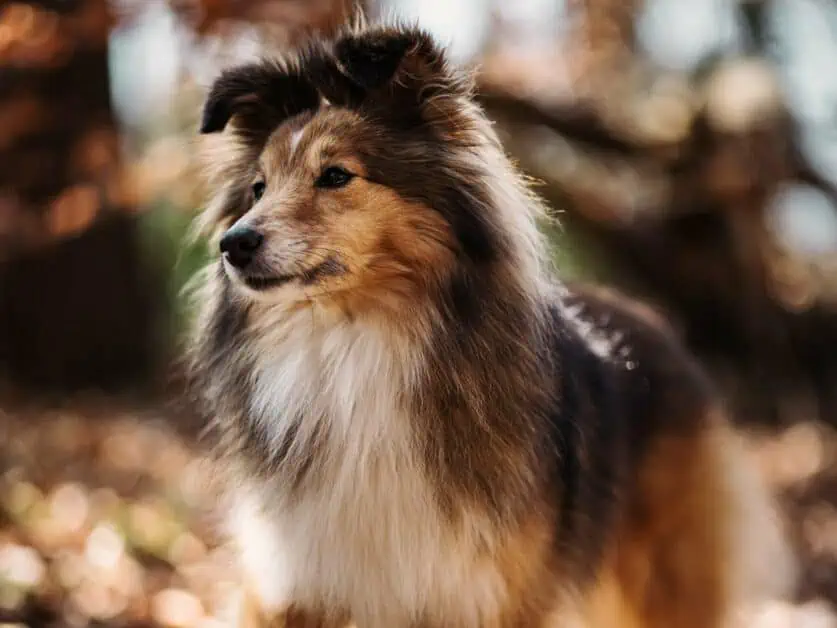
The Shetland Sheepdog ticks a lot of boxes for the ideal dog: They are friendly, highly intelligent, and generally easy to train. It’s subjective, but it’s fair to say that they are also an elegant and handsome breed. These dogs originated on the Shetland Islands, north of Scotland.
Energy and Stamina
Originally bred to work as herding and protection animals in harsh Subarctic conditions, these dogs are capable of great stamina and energy. With the right training, a Shetland Sheepdog will have no problem following along on even the most demanding hikes.
Size
Shetland Sheepdogs are small to medium sized dogs. A full-grown and healthy male with have a shoulder height of up to 40cm/16in and weigh up to 11kg/25lbs. It’s not uncommon for Shetland Sheepdogs to be smaller than this and females are generally a little smaller than males.
Intelligence and Trainability
These dogs are renowned for their intelligence and receptiveness to training. This makes them a great choice for inexperienced or first-time dog owners. These dogs have an instinct to herd and nipping is part of these behaviors. This needs to be discouraged through training as it can lead to biting.
Socialization
The Shetland sheepdog is renowned for its friendly personality and these dogs are recommended for families with young children. They also generally get along well with other smaller animals including cats. In both situations, training is key.
Noise Sensitivity
Like all dogs, Shetland Sheepdogs can be startled by sudden or loud noises. This can cause the animal serious distress and it’s important to integrate noise awareness into the animal’s training to help address this.
Grooming
Shetland Sheepdogs were originally bred on a Subarctic Island, and their thick, dense coat is an adaptation to this. The coat requires regular grooming to keep it in best condition and to help prevent matting.
Health
Shetland Sheepdogs are generally healthy animals, but they can suffer from Hip Dysplasia – a joint condition that can lead to arthritis and also eye conditions. As with all pets, regular check-us with a vet along with a good, balanced diet and regular exercise are all key to keeping a Shetland Sheepdog healthy.
Cockapoo
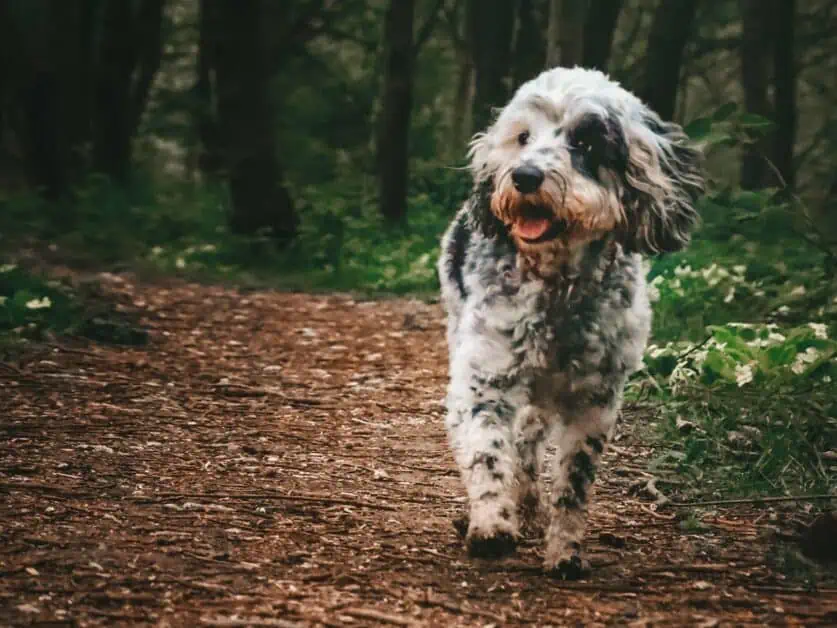
Like the Labradoodle mentioned above, the Cockapoo is not a true breed, but rather a hybrid between a Poodle and Cocker Spaniel. You might also hear these dogs referred to as ‘Cock-a-poos’, ‘Cockapoodles’, ‘Spoodles’ or other variants on the name. Originating in America in the 1960s, the Cockapoo is an immensely popular pet these days, and it really is not hard to see why: They are friendly, outgoing and easy to train. Their melt-your-heart teddy bear looks are surely also an important factor for many people.
Energy and Stamina
Whilst the Cockapoo is a modern ‘designer’ hybrid, the two dogs that contribute to the mix – the Cocker Spaniel and the Poodle – are working breeds capable of great physical stamina. Whilst Cockapoos do not have intensive exercise requirements, with the right training, they will easily be capable of tagging along on long distance hikes.
Size
As Cockapoos are not a breed, there is no ‘standard’ for their size and weight, and both can vary considerably. Broadly speaking, shoulder height can range from 25-40cm/10-16in and weight from 3-9kg/6-20lbs in a healthy adult.
Intelligence and Trainability
The Cockapoo is regarded as an intelligent dog that’s receptive to training. They are recommended as a great choice for inexperienced owners. However, this comes with a serious caveat: There are plenty of irresponsibly bred cockapoos out there – many from inhumane ‘puppy farms’ – who can be difficult to train and exhibit problematic traits. If you do decide to get a Cockapoo puppy, be sure to do so from a reputable and thoroughly researched breeder.
Socialization
A Cockapoo can be an absolute joy to own they are friendly, playful (but not overly ‘in your face’) and can be great with other animals and children.
Noise Sensitivity
Like most animals, Cockapoos can be deeply distressed by sudden or loud noises. This can be a real problem and it’s important to integrate noise awareness into the animal’s training to help minimize the negative impact this can have.
Grooming
Cockapoo’s coats can vary, but they typically have a dense, curly coat inherited from the Poodle portion of their mix. This coat is surprisingly low maintenance, and the good news is that it usually inherits the hypoallergenic qualities of the poodle coat – meaning these dogs can be a great choice for allergy sufferers. Cockapoos benefit from weekly brushing at a minimum and animals with longer fur will also benefit from professional trims – especially so in warmer weather.
Health
Cockapoos are generally quite healthy. In common with most dogs, they can suffer from Hip Dysplasia – a joint condition that can lead to arthritis – along with eye and ear conditions. Regular vet visits plus a good diet and exercise are the best way to keep a cockapoo in peak health and to catch any conditions before they become too serious.
English Spring Spaniel
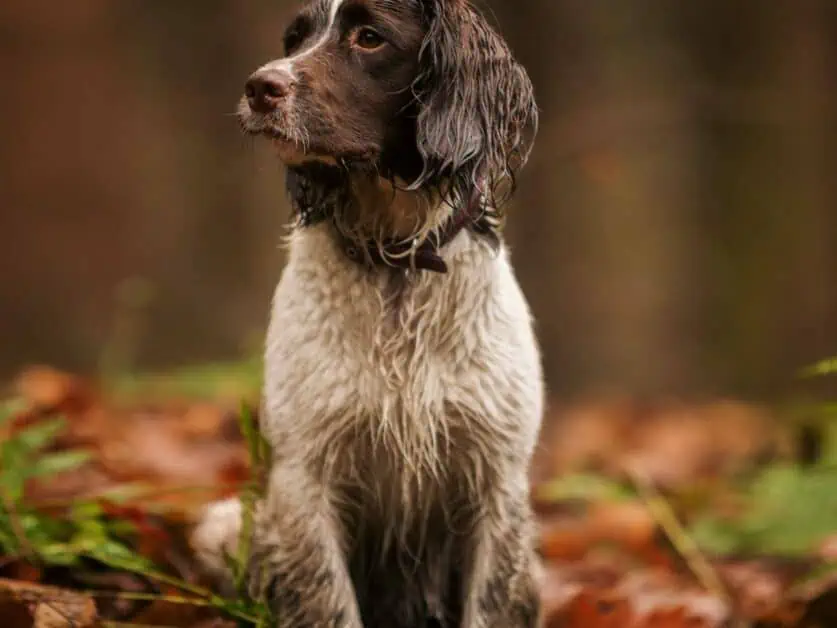
The English Springer Spaniel is an understandably popular breed. These dogs are known for their friendly and playful, almost goofy personality and boundless energy. Their sleek mid-length coats and droopy ears covered in slightly longer, often curly fur also certainly contribute to making these dogs endearing. The iconic Springer Spaniel is deep chocolatey brown and white, but these dogs come in a wide variety of colors. This breed has a long history and whilst the modern breed originated in England, Spaniels likely spread from Spain with the Roman Empire and there are references to these dogs in texts dating back close to two thousand years.
Energy and Stamina
English Springer Spaniels were originally bred as hunting dogs. The ‘Springer’ part of their name refers to a near-vertical leap the dogs will instinctively perform to startle prey animals. This is a physically demanding task and, as such, these dogs have a tremendous energy and, with the right training can take even the longest hikes in their stride.
Size
English Springer Spaniels are a small to medium sized dog. Full grown healthy adults will have a shoulder height ranging from 45-58cm/18-23in and weigh in the region of 20-25kg/45-55lbs. Adult males are usually slightly larger than females.
Intelligence and Trainability
The English Springer Spaniel is renowned as a breed that’s intelligent and easy to train. In this regard, they are a great choice for a first-time dog owner. They do very well at obedience training and in trials.
Socialization
The English Springer Spaniel is renowned for its generally happy and playful personality. These are dogs that love humans and delight in interaction. In this sense, they can be quite ‘in your face’. The breed generally also does very well with small children and other pets – though as they were originally bred to hunt birds, it’s generally not advised to keep birds and Springer English Spaniels in the same house.
Noise Sensitivity
Like all dogs, English Springer Spaniels can be agitated and distressed by loud or sudden noises. It’s important to integrate noise awareness into their training to help minimize this.
Grooming
English Springer Spaniels have a mid-length coat with slightly longer fur on their ears. They will benefit from weekly brushing and baths if they get particularly dirty.
Health
English Springer Spaniels are generally healthy, but they can be prone to Hip and Elbow Dysplasia – a joint condition that can lead to arthritis. They can also be prone to eye problems. Regular check ups with the vet are the best way to catch any health problem before it becomes too serious and a good, balanced diet and regular exercise are, of course, also vital in keep these, or any dogs, in good health.
Mixed Breed Hiking Dogs

The common Mutt or Mongrel, for many dog lovers, is the best choice full stop and adopting a mixed breed from a shelter or animal rescue will be the path to dog ownership most people take. Throughout this article, we have listed and discussed the various strengths or characteristics of various breeds, but the fact is that mixed breed dogs can exhibit many of these same traits too, and what’s more they’ll often combine the best elements from several breeds in one package.
Why are Mixed Breeds a Good Choice
Sadly, shelters are overflowing with unwanted animals and whatever the case, it’s never the animal’s fault that it ends in a shelter. Adopting a dog from a shelter – especially an adult dog (most people prefer younger animals) – is a great way to give a deserving animal a second chance. It’s often said that ‘rescue is the best breed’ and frankly we couldn’t agree more!
Finding the Right Mixed Breed Dog for Hiking
Mixed breed dogs can vary wildly in terms of size, personality, and care requirements. The best course of action is to speak to staff about your living and work arrangements as well as describing what you are hoping for in a hiking companion and let them guide you. The staff at shelters will often have a good understanding of the personalities of the animals they have in their care and will usually be in a great position to suggest a match.
Training your Hiking Dog
Just as you wouldn’t expect a human who has never hiked before to be able to instantly scale a steep mountain or complete an all-day backcountry hike, the same goes for dogs and unless you adopt an animal that’s already been used to a very active lifestyle, then training your dog so it’s accustomed to the trail and covering longer distances is essential. Physical training is just one part of this, and obedience training is crucial too.
Sometimes, despite your best efforts, dogs are not responsive to training. This can be for many reasons, but common scenarios involve adopted dogs that have previously suffered some form of trauma or have been trained to be aggressive. In these cases, professional dog behaviorists can provide intensive and specialized training that can make a world of difference.
Obedience Training
Obedience training is the foundation of dog training. This is teaching a dog to not only recognize but also obey spoken commands that you give. It’s also a great way to build a bond between you and your dog. The American Kennel Club and the RSPCA both have extensive resources online to help with this.
Building Hiking Endurance for the Trail
Building your dog’s hiking endurance for the trail is a very similar process to what you would do if you were starting to hike yourself. Start off on shorter, easier trails with your dog, progressing up to longer and more demanding terrain over time. The key here is not just to build your dog’s fitness, stamina, and endurance, but also for you to build your understanding of your dog’s capabilities and what, if any, hard limits it may have. Remember, the hike should be enjoyable for both of you!
Trail Etiquette – How to Behave on the Trail
If you are in an area where dogs are permitted off-lead, be sure your dog is well-trained to obey several key commands (primarily ‘Leave it’ and ‘come back’). If you have a larger dog that could be intimidating to people, be prepared to put it back onto its lead if you approach groups of other hikers. If you are using a permissive route or right of way through private land and signs request that you keep your dog on a leash, then absolutely do so. Finally, and it should go without saying, but always carry poop bags and clean up after your dog – this is common decency and should be no different on the trail.
FAQs
Can any dog be a hiking dog?
Any dog that’s physically able to do so will love to walk, and as such, you take any dog on the trail, however some dogs are inherently better suited to long hikes than others.
Are there any dogs that are not suited to hiking?
Any dog that is physically infirm, is very old or very young will surely struggle on longer hikes. Some Brachycephalic or ‘flat faced’ breeds like Bulldogs and Pugs can suffer from extreme breathing difficulties which means that intense physical activity can harm them.
Is training necessary for hiking dogs?
Dogs can easily get distracted by wildlife and may be prone to just running off in the outdoors. Obedience training is key if you want to walk with your dog off-lead in nature.
I’ve taken on an adult rescue dog from a shelter that has never hiked. Can this dog become a hiking dog?
Just like humans, don’t expect any dog to be able to hike long distances without any training. Build up with progressively longer walks and hikes and do outdoors obedience training too. Enjoy this process! It’s a great way for you and your dog to bond!
What supplies should I bring on a hike for my dog?
A lot depends on your dog, what it likes and how long you will be hiking for. Consider, though, that dogs get hot, cold, hungry, thirsty, and tired just as humans do and this doesn’t change on a hike. At the very least, and even on short hikes, you should bring extra water for your canine companion – as dog backpack can be a great addition.
Conclusion
Dogs are wonderful companions – not just on the trail but also in life too. For those who hike solo, the presence of a dog can make journeys into the backcountry seem less lonely and isolated. Talk to ‘dog people’ and it won’t be long before you hear that certain dogs have a way of empathizing and interacting with their owners that can feel very human indeed. It’s understandable that many owners want to share the joy they experience in the outdoors with their dogs – and surely the dog’s presence makes the experience even more enjoyable too!
Disclaimer: This article contains Affiliate Links. You won’t pay any more for buying through these links, but we may receive a commission from any purchases made through them. As an Amazon Associate, I earn from qualifying purchases. If you choose to support us by buying through our links, we thank you as it helps us to continue providing the resources we do to help you enjoy the outdoors more!
